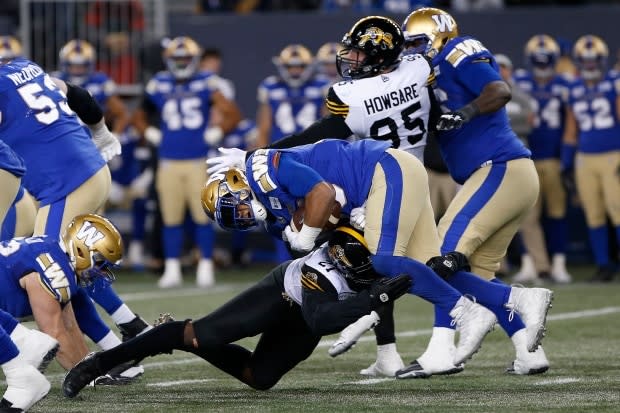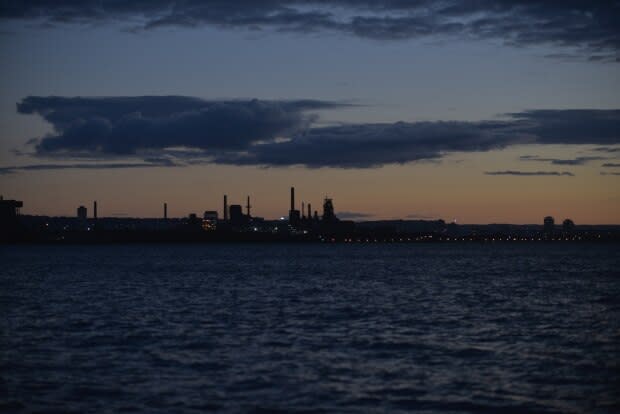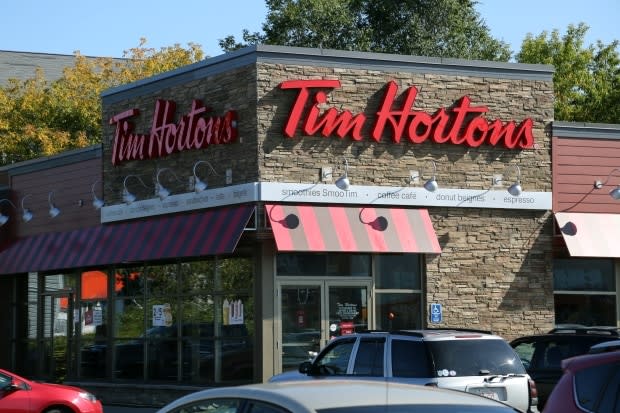Black coffee and Balsillie: Concocting a Winnipeg-Hamilton rivalry, off the field
On the basis of past performance, the Hamilton Tiger-Cats are favoured to win the Grey Cup over the Winnipeg Blue Bombers this weekend.
The comparison between the two clubs is clear: the TiCats finished the regular season with a more potent offence, a stingier defence and a better overall record. The Bombers are considered underdogs for good reason.
Off the field, however, the rivalry between the two Grey Cup-combatant cities is a lot muddier.
Winnipeg and Hamilton haven't faced each other in Canadian Football League championship since 1984, when the Bombers erased an early deficit to win blow out the TiCats 47-17. Many Hamilton fans are too young to remember this — or the last time the Bombers won a championship, period.
The clubs' fan bases are more likely to respect each other than hate each other, given that they both live in somewhat gritty industrial cities with perennially competitive football teams that nonetheless have not won a Grey Cup since the 1990s.
"My feeling is Hamilton is actually very similar to Winnipeg," Winnipeg Mayor Brian Bowman said Wednesday. "It's a city with folks that work hard. It has a certain amount of grit."
Hamilton, he said, "has historically been known as a blue-collar town, and Winnipeg has as well. We work hard and we really rally behind our team."
There's simply little to place Winnipeg and Hamilton in conflict, at least on the scale of a Winnipeg-Regina rivalry on a Labour Day weekend or any Calgary-Edmonton NHL game.
So in an effort to stir up a semblance of a mutual hatred where none really exists, here are three areas where the two cities can compete:
Lingering Jets jealousy
A decade ago, when it looked like the team then known as the Phoenix Coyotes would not last another sweltering season in the Arizona desert, Hamilton entrepreneur Jim Balsillie did his best to try move the struggling hockey team to Hamilton.

Balsillie made his fortune creating BlackBerry, the mobile email gadget that sat in every important person's pocket prior to the invention of the iPhone. He was a big Hamilton booster and attempted to pry the Coyotes out of Glendale, Ariz., and plop them down into Copps Coliseum.
Balisillie tried to buy a nearly bankrupt Coyotes club and move it north. The problem is, one does not simply move an NHL team.
League commissioner Gary Bettman was never onside with the plan, and not just because of Hamilton's proximity to Toronto and the Maple Leafs. As Mark Chipman of Winnipeg's True North Sports and Entertainment would soon prove, Bettman preferred to deal with potential new owners who worked quietly and politely behind the scenes.
In 2010, the Coyotes almost wound up in Winnipeg before a Glendale council approved a bailout package. The NHL finally returned to Winnipeg in 2011, when True North snapped up the ailing Atlanta Thrashers.
Hockey fans in Hamilton could only sit and watch and wonder, "why not us?"
Advantage: Hamilton. As Winnipeggers can attest, there's nothing quite like the agony of a scorned hockey fan.
The identity question
Population-wise, Winnipeg and Hamilton are both third-tier Canadian cities.
When you combine their metropolitan areas, Toronto, Montreal and Vancouver account for a third of Canada's population. Calgary, Edmonton and Ottawa-Gatineau each have metro areas with about 1.5 million people, according to Statistics Canada.
Then come Winnipeg, Quebec City and Hamilton, each with census metropolitan areas in the 800,000 range. Winnipeg's metro population was pegged at 832,000 last year. The Hamilton area had 778,000.

This makes the two Grey Cup competitor cities similar to each other — until you take their neighbours into account.
Culturally and economically, Hamilton will forever sit in the shadow of Toronto, its massive Lake Ontario neighbour.
Winnipeg sits next to ... well, nobody. The nearest larger city to the Manitoba capital is Minneapolis-St. Paul, seven hours away on interstate highways 29 and 94.
Winnipeg's geographic isolation can be used to explain its outsized sense of regional identity. The mere word "Winnipeg" evokes strong reactions across Canada, both positive and negative.
Hamilton's proximity to Toronto means Canadians may not have a clear idea what Hamilton is at all.
Advantage: Winnipeg, notwithstanding epithets such as "Loserpeg" and "Winterpeg."
The Franchise Food Fight
The most well-known Winnipeg restaurant franchise is Salisbury House, which has served up burgers slathered in fried onions for 88 years.
The first Sals opened on downtown Winnipeg's Fort Street in 1931, when visiting American actor Ralph Erwin couldn't find anywhere to fill his tummy late at night, according to the company's history.
He named his burgers "nips," a name that sowed confusion among other U.S. visitors only a decade later. During the Second World War, the singular form of the noun — an abbreviation of Nipponese — went into wide circulation as an anti-Japanese racial slur.
Nonetheless, the colloquial use of the "nip" survived in Winnipeg as a synonym for hamburger. The Salisbury House chain also endured, despite experiencing ups and downs.

The most famous Hamilton-born franchise is Tim Hortons, which was founded in 1964 by the hockey player of the same name. Horton died in 1974 in a single-vehicle collision on southern Ontario's Queen Elizabeth Expressway; an autopsy made public decades later revealed he had been drinking.
Nonetheless, Tim Hortons, the coffee shop, did more than just endure. The brand has become synonymous with Canadian culture, despite recent frictions between franchisees and the corporate ownership of Restaurant Brands International.
There were 4,846 Tim Hortons around the world in 2018, according to RBI's most recent annual report.
There are 14 Sals locations in Winnipeg and one in Steinbach, according to the company's website.
Advantage: Hamilton. Heck, the TiCats play at Tim Hortons Field.



